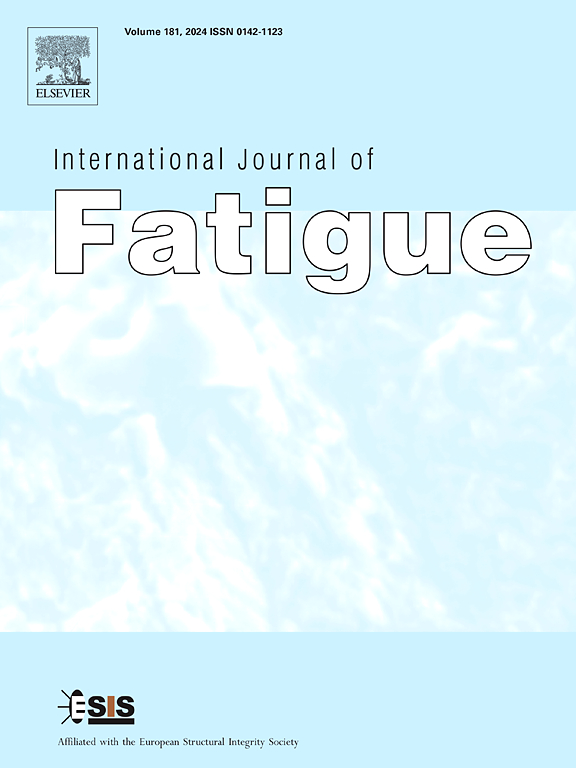探讨GCr15轴承滚动接触疲劳时相组织演化机制
IF 5.7
2区 材料科学
Q1 ENGINEERING, MECHANICAL
引用次数: 0
摘要
深入研究了GCr15轴承构件在高周次载荷作用下的地下接触疲劳失效,重点研究了滚动构件球和内外滚道随时间变化的微观组织演化机制。为此,实施了专门的实验策略,通过系统地更换滚动元件来保持轴承几何形状的一致,同时保持结构的完整性。该方法能够全面观察和分析整个失效过程中随时间变化的微观结构转变,促进对渐进降解过程中微观结构演变的精确时间跟踪。显微结构特征,包括晶粒尺寸、位错密度和相变,用电子背散射衍射进行了量化。然后将这些指标与暗蚀刻区域(DERs)的分布以及在不同交变应力条件下产生的应力场相关联。分析表明,晶粒细化是控制亚表面组织变化的主要机制,近表面区域在操作过程中晶粒尺寸减小了约50%。此外,研究表明,不同承载单元的应力条件可能显著影响其微观结构响应,可能导致显着的DER形成。这些发现提供了对滚动接触失效机制的见解,并强调了应力条件和微观结构变化之间关系的重要性。本文章由计算机程序翻译,如有差异,请以英文原文为准。
Towards understanding the time-dependent microstructural evolution mechanism of GCr15 bearing in rolling contact fatigue
We conducted an in-depth investigation into the subsurface-initiated rolling contact fatigue failure of GCr15 bearing elements subjected to high-cycle loading, emphasizing the comprehensive understanding on the time-dependent microstructural evolutions mechanism with respect to the rolling element ball and inner/out raceway. To this end, a specialized experimental strategy was implemented, maintaining consistent bearing geometry through systematic replacement of rolling elements while preserving structural integrity. This methodology enabled comprehensive observation and analysis of time-dependent microstructural transformations throughout the failure process, facilitating precise temporal tracking of microstructural evolution during progressive degradation. Microstructural features, including grain size, dislocation density, and phase transformations, were quantified using electron backscatter diffraction. These metrics were then correlated with the distribution of dark etching regions (DERs) and the stress fields generated under varying alternating stress conditions. The analysis revealed that grain refinement was the dominant mechanism governing the subsurface microstructural changes, with the near-surface region exhibiting approximately a 50% reduction in grain size during operation. Furthermore, the study suggests that stress conditions in different bearing elements may significantly influence their microstructural responses, potentially leading to notable DER formation. These findings provide insights into rolling contact failure mechanisms and highlight importance of relationship between stress conditions and microstructural changes.
求助全文
通过发布文献求助,成功后即可免费获取论文全文。
去求助
来源期刊

International Journal of Fatigue
工程技术-材料科学:综合
CiteScore
10.70
自引率
21.70%
发文量
619
审稿时长
58 days
期刊介绍:
Typical subjects discussed in International Journal of Fatigue address:
Novel fatigue testing and characterization methods (new kinds of fatigue tests, critical evaluation of existing methods, in situ measurement of fatigue degradation, non-contact field measurements)
Multiaxial fatigue and complex loading effects of materials and structures, exploring state-of-the-art concepts in degradation under cyclic loading
Fatigue in the very high cycle regime, including failure mode transitions from surface to subsurface, effects of surface treatment, processing, and loading conditions
Modeling (including degradation processes and related driving forces, multiscale/multi-resolution methods, computational hierarchical and concurrent methods for coupled component and material responses, novel methods for notch root analysis, fracture mechanics, damage mechanics, crack growth kinetics, life prediction and durability, and prediction of stochastic fatigue behavior reflecting microstructure and service conditions)
Models for early stages of fatigue crack formation and growth that explicitly consider microstructure and relevant materials science aspects
Understanding the influence or manufacturing and processing route on fatigue degradation, and embedding this understanding in more predictive schemes for mitigation and design against fatigue
Prognosis and damage state awareness (including sensors, monitoring, methodology, interactive control, accelerated methods, data interpretation)
Applications of technologies associated with fatigue and their implications for structural integrity and reliability. This includes issues related to design, operation and maintenance, i.e., life cycle engineering
Smart materials and structures that can sense and mitigate fatigue degradation
Fatigue of devices and structures at small scales, including effects of process route and surfaces/interfaces.
 求助内容:
求助内容: 应助结果提醒方式:
应助结果提醒方式:


